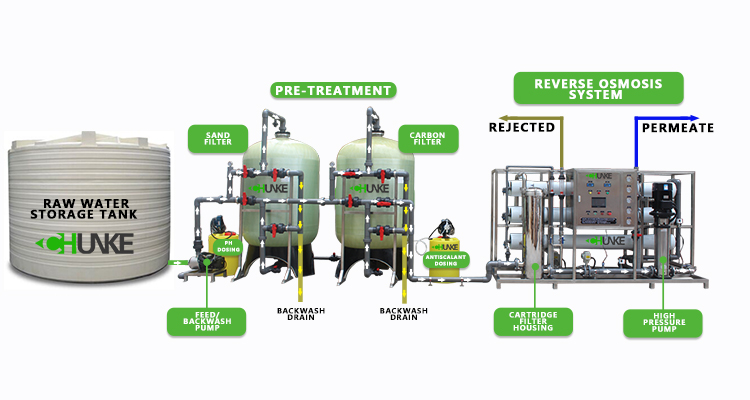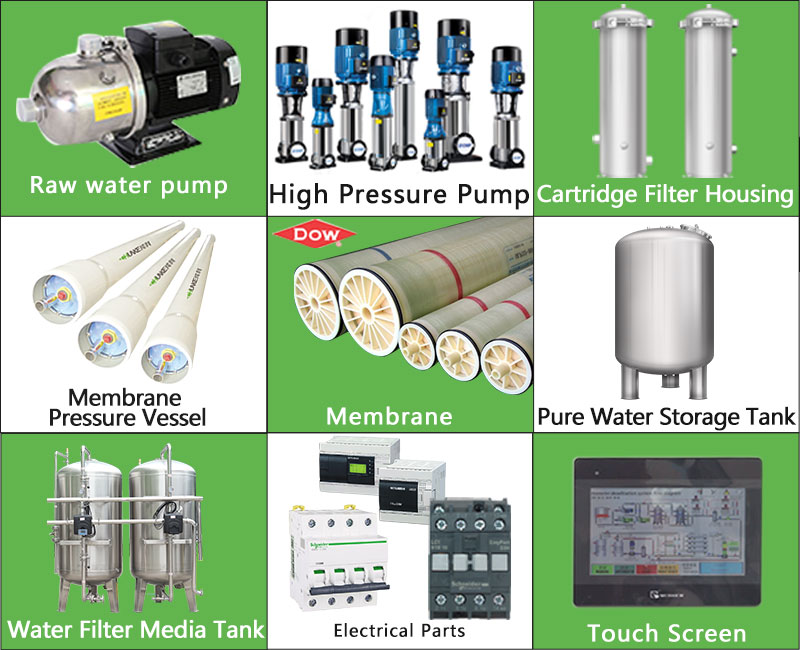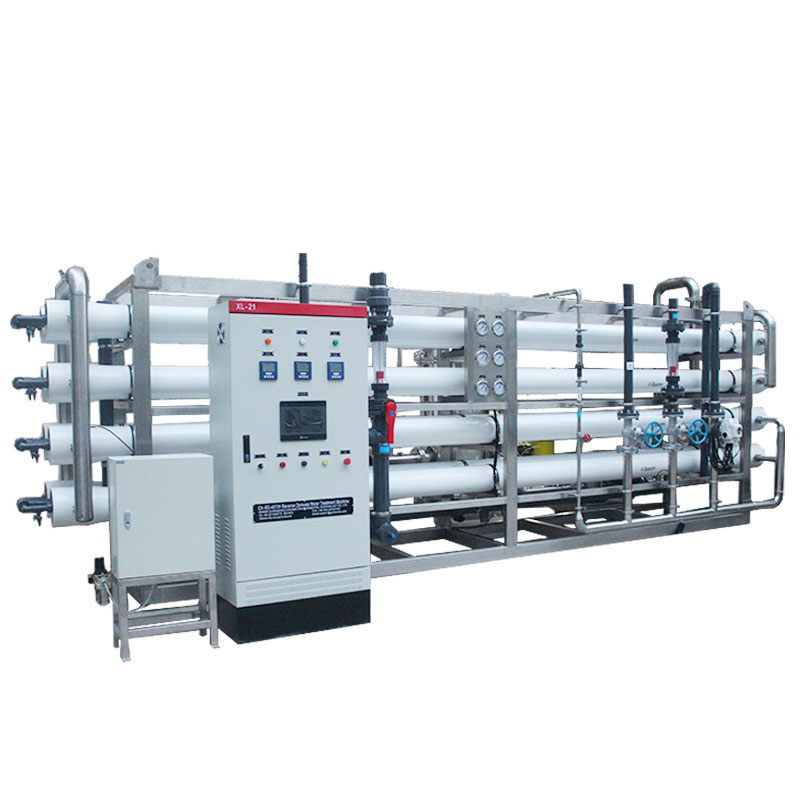How much does a 3000 L/h RO system cost?
Reverse osmosis (RO) technology is one of the most effective and widely used technologies in water treatment, which can effectively remove dissolved salts, organic matter, bacteria and other impurities from water. 3000 L/h RO systems are widely used in industrial, commercial and large public facilities due to their high efficiency and moderate size. This article will discuss in detail the main factors affecting the price of 3000 L/h RO systems, and provide price ranges and related case studies in the market.

What are the components of a RO system?
Before understanding the price, you first need to understand the basic composition of a 3000 L/h RO system. This system usually includes the following main components:
1. Pretreatment equipment: such as sand filters and activated carbon filters, which are used to remove suspended matter, organic matter and chlorine from water.
2. High-pressure pump: Provides the required high pressure to pass water through the RO membrane.
3. RO membrane assembly: The core part, used to remove dissolved substances from water.
4. Control system: including PLC controller, human-machine interface, etc., used to monitor and adjust the operation of the system.
5. Post-treatment equipment: such as ultraviolet disinfector, mineralization filter, etc., used to further treat the produced water.
6. Water storage tank: used to store treated pure water.
7. Pipes and valves: connect various components to control the direction and flow of water.

What are the main factors affecting the price of reverse osmosis system?
1. Pretreatment equipment
The selection and configuration of pretreatment equipment have an important impact on the price of the system. For raw water with poor water quality, more complex pretreatment systems such as multi-stage sand filters and activated carbon filters are required to ensure the life of the reverse osmosis membrane and the stable operation of the system.
● Simple pretreatment system: suitable for raw water with good water quality, the price is relatively low.
● Complex pretreatment system: suitable for raw water with poor water quality, the price is higher.
2. Reverse osmosis membrane
The reverse osmosis membrane is the core component of the system, and its quality and performance directly affect the efficiency and life of the system. High-quality reverse osmosis membranes have higher rejection rates and longer service life, but they are also more expensive.
● Standard reverse osmosis membranes: good performance, suitable for most water quality conditions, moderate price.
● High-performance reverse osmosis membranes: suitable for occasions with poor water quality or high water quality requirements, high price.
3. High-pressure pumps
The selection of high-pressure pumps has an important impact on the operating efficiency and energy consumption of the system. High-efficiency and durable high-pressure pumps are more expensive, but can provide stable operation and low maintenance costs.
● Ordinary high-pressure pumps: suitable for general purposes, low price.
● High-efficiency high-pressure pumps: suitable for occasions with high energy consumption and stability requirements, high price.
4. Control system
The complexity and degree of automation of the control system have a direct impact on the price of the system. Advanced control systems can achieve more precise control and monitoring, and improve the operating efficiency and reliability of the system.
● Basic control system: manual operation, low price.
● Advanced control system: high degree of automation, with remote monitoring and alarm functions, high price.
5. Post-processing equipment
The type and quantity of post-processing equipment depends on the final use of the produced water. Applications that require high-purity water or specific water quality requirements often require more post-processing equipment.
● Simple post-processing equipment: suitable for general use, low price.
● Complex post-processing equipment: suitable for specific uses, such as pharmaceuticals and electronic manufacturing, and high price.

What is the price of a 3000 L/h reverse osmosis system?
Based on the above factors, there are large differences in the market price of a 3000 L/h reverse osmosis system. The following is a price range based on market research:
● Basic system: about 10,000 to 30,000 US dollars. Including simple pre-treatment equipment, standard reverse osmosis membrane, ordinary high-pressure pump and basic control system, suitable for applications with good water quality and low water quality requirements.
● Mid-range system: about 30,000 to 60,000 US dollars. Including relatively complete pre-treatment equipment, high-performance reverse osmosis membrane, high-efficiency high-pressure pump and mid-to-high-level control system, suitable for applications with general water quality and certain water quality requirements.
● High-end system: about 60,000 to 100,000 US dollars. It includes complex pretreatment equipment, top-level reverse osmosis membranes, state-of-the-art high-pressure pumps and fully automated control systems, suitable for applications with poor water quality or extremely high water quality requirements.
3000 L/H Reverse Osmosis System Price Actual Application Case Analysis
Case 1: Reverse Osmosis System in a Chemical Plant
A chemical plant needs a 3000 L/H reverse osmosis system for process water and employee drinking water. Due to the poor quality of the raw water, which contains a large amount of suspended solids and organic pollutants, the chemical plant chose a mid-range system equipped with multi-stage sand filters, activated carbon filters and high-performance reverse osmosis membranes. The total price of the system is US$50,000.
● Configuration: multi-stage sand filters, activated carbon filters, high-performance reverse osmosis membranes, high-efficiency high-pressure pumps, mid- and high-level control systems.
● Result: The system operates stably, and the water quality of the produced water meets the national drinking water standards, meeting the process and drinking needs.
Case 2: Reverse Osmosis System in a Hotel
A five-star hotel needs a 3000 L/H reverse osmosis system for guest rooms and restaurants. The hotel has extremely high requirements for water quality, requiring the produced water to be odorless, free of impurities, and free of microorganisms. The hotel chose a high-end system, equipped with the most advanced pretreatment equipment and reverse osmosis membrane, and equipped with a UV sterilizer and a mineralization filter. The total price of the system is $100,000.
● Configuration: multi-stage pretreatment equipment, top-level reverse osmosis membrane, high-efficiency high-pressure pump, fully automated control system, UV sterilizer, mineralization filter.
● Result: The system operates stably, the water quality is excellent, and it meets the high standards of a five-star hotel.
Case 3: Drinking water project in a rural area
A rural area installed a 3,000 liter/hour reverse osmosis system with government funding to solve the drinking water problem of local residents. Due to limited funds, a basic system was selected, equipped with simple pretreatment equipment and standard reverse osmosis membrane. The total price of the system is $20,000.
● Configuration: simple pretreatment equipment, standard reverse osmosis membrane, ordinary high-pressure pump, basic control system.
● Result: The system operates well, the water quality of the produced water is significantly improved, and the drinking water problem of residents is effectively solved.

Conclusion
The 3000L/h reverse osmosis system is widely used in various water treatment needs due to its high efficiency and moderate scale. The system price is affected by factors such as pretreatment equipment, reverse osmosis membrane, high-pressure pump, control system and post-treatment equipment, and there are large differences. Through reasonable selection and configuration, it can meet the needs of different water quality and application scenarios.






